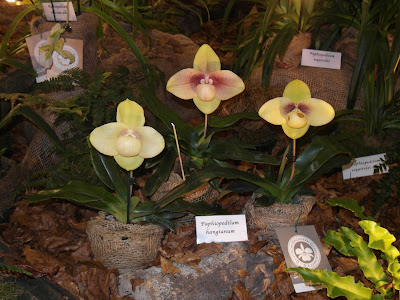Hang's Paphiopedilum orchid is native Northern Vietnam. According to reports, this orchid grows on limestone rocks in niches filled with moss covered with mists, in slightly shaded places, at heights of 800-1000 m. The exact location is not certain. There are reports of occurring near the Chinese border, probably in the Bac Thai Province, but the original habitat may be located further north in the Cao Bang Province.
Paphiopedilum hangianum orchid, also called Hang's Paphiopedilum, Paphiopedilum hangianum f. album, Paphiopedilum singchii, is a species of the genus Paphiopedilum. This species was named after Mrs. Thong Ngoc Hang from Vietnam, who breeds and exports this species, and was described by in Perner & Gruss 1999.
IDENTIFY PAPHIOPEDILUM HANGIANUM ORCHID
Hang's Paphiopedilum orchid is native Northern Vietnam. According to reports, this orchid grows on limestone rocks in niches filled with moss covered with mists, in slightly shaded places, at heights of 800-1000 m. The exact location is not certain. There are reports of occurring near the Chinese border, probably in the Bac Thai Province, but the original habitat may be located further north in the Cao Bang Province. It is very likely that this rare and certainly locally endemic species has already been lost in nature due to excessive collection for commercial purposes.
This species is a rare, medium sized, hot to warm growing lithophyte, with height up to 25 cm, with 4 to 7 distichous, coriaceous, ligulate, obtuse or subacute, glossy green above, paler green below, sharply keeled beneath leaves. The leaves are about 25 cm long.
It blooms in the spring on a single flowered, erect, 2 1/2 to 4 3/4" (6 to 12 cm) long, bright green, shortly white-pilose, terminal inflorescence with an ovate, obtuse, conduplicate, green, white-pubescent bract and carrying a slightly sweet smelling, large flower. The flower is 9-12 cm in diameter. The petals and sepals are colored greenish-yellow, pale yellow, cream or peach color. Petals can have chestnut, reddish or brownish-purple veins. The sacciform lip is usually of a lighter color.
GROW AND CARE PAPHIOPEDILUM HANGIANUM ORCHID
Cultural information should only be used as a guide, and should be to be adapted to suit you. Your physical location; where you grow your plants, how much time you have to devote to their care, and many other factors, will need to be taken into account. Only then can you decide on the cultural methods that best suit you and your plants.
Light:
Hang's Paphiopedilum need a light level of 18000-25000 lux. These plants require filtered or diffused light and should not be exposed to the direct sunlight of the midday sun. The light level similar to other species from this region should therefore be taken as the starting point. If the plants do not bloom, the level of light can be gradually increased. Strong air movement should be ensured all the time.
Temperature:
The average temperature of the summer day is 28 ° C, the night 20 ° C, and the daily difference is 8 ° C. The average temperature of the winter day is 14-17 ° C, the night 6-8 ° C, and the daily difference is 7-9 ° C. The calculated lowest temperatures suggest that these plants in the wild may occasionally experience temperatures below 0 ° C, but the minimum winter temperatures may be slightly higher.
Humidity:
Most of the year the humidity is 80-85%, falling to 75-80% during the dry period, which occurs in winter and spring.
Substrate and growing media:
This plant can be grown in plastic pots with a loose, water-conducting substrate that retains moisture, but does not soak. To retain moisture near the roots in the substrate add sliced sphagnum. This is especially important if the orchid is kept in a room with low humidity.
Despite the fact that in nature this orchid grows on limestone rocks, it is not recommended to add it in the substrate because the contact with cold water and the fertilizer causes it to decompose, accumulating toxic substances around the roots.
Watering:
In the habitats of the Paphiopedilum hanguianum from late spring to autumn heavy rain falls, after which a dry period lasting from 4 to 5 months begins. In culture, the plant should be watered abundantly during the growing season (March-September), but the substrate should not be soggy or damp. Hang's Paphiopedilum need watering when the substrate has dried well but before it becomes completely dry. During the winter, the quantities of water are reduced, and the wetting occurs when the substratum is almost completely dry.
Fertilizer:
This species is fertilized only during the growth period using 1/4 of the dose indicated on the bottle of a suitable liquid fertilizer for orchids. The fertilizations are done once every four watering. Before fertilizing the plant it is important to water it to avoid the harmful contact of the manure with the dry roots.
Rest period and repotting:
In the culture of the plant in winter, less water is required, but the substrate must not completely dry out. In between irrigation it is useful from time to time to spray the plant. The frequency of spraying depends on the light and temperature. Fertilization should be reduced or eliminated until spring, when new growths appear and regular watering begins.















It would be NICE if you gave me the photo credit that I deserve!
ReplyDeletePlease, send me your profile as credit and i will add its! Its my fault!
Delete